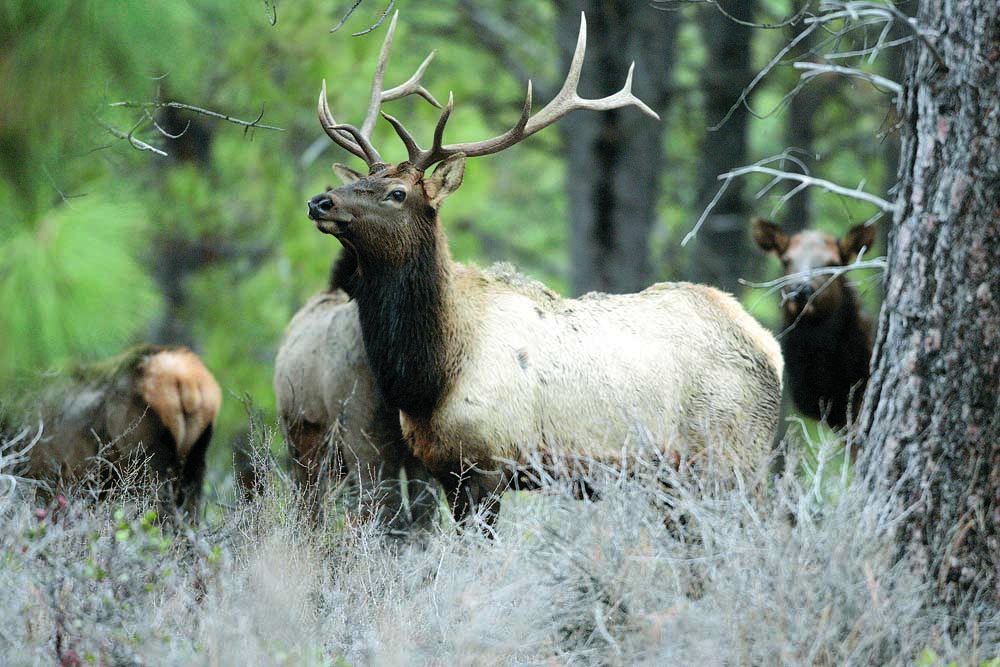Elk can damage golf courses
Published 12:00 am Monday, December 2, 2013

- Andy Tullis / The Bulletin file photoAn elk is pictured in this file photo.
Mark Amberson remembers the December morning in 2007 when he first saw a herd of elk at Awbrey Glen Golf Club.
Amberson was Awbrey Glen’s first golf pro when the private club opened in northwest Bend in 1993, but the sight was a new one for him.
That is not the case anymore.
Since that day six years ago, a herd of nearly 90 elk has spent most winter days grazing on the course.
“We spent a lot of time and money repairing damages done by the elk,” says Amberson, who is now the club’s general manger.
Elk, which can weigh as much as 1,000 pounds, can do a number on a golf course. Not only can their sheer size trample sensitive greens, but more commonly, the animals’ feces can pile up, causing hours of work for a course’s maintenance staff. And elk urine can damage turf.
This fall, Awbrey Glen has installed 1,000 feet of game fencing, a project undertaken in cooperation with the Oregon Department of Fish and Wildlife and the surrounding homeowners, Amberson says.
The idea is not to rid the course of the elk completely.
“We don’t think that we can keep the elk entirely off the golf course,” Amberson says. “We are just trying to … put up some game fencing along our western boundary so that we can, if nothing else, reduce the number of days that they are on the property.”
Nearly every Central Oregon golf course near forest land must deal with the majestic animals, says Corey Heath, Deschutes District wildlife biologist for the ODFW.
In golf courses, elk find plentiful feeding grounds during the winter, Heath adds.
“It’s not an uncommon problem,” says Heath, who consulted with Awbrey Glen on its fence project. “Elk and deer and other animals move downslope to get out of the snows, and golf courses, for the most part, are still fairly green throughout the winter months. And (golf courses) are either on winter range or transition range (for elk), and they’re pretty attractive to elk. Elk, unlike deer, are more grazers.”
Heath has grown accustomed to providing Central Oregon golf courses with advice on how to manage elk.
For some, including Quail Run Golf Club in La Pine, it is a daily issue in the colder months.
Quail Run hosts a herd of about 65 elk each winter. Fuel, labor costs and damage to greens and fairways “equates to thousands of dollars,” says Todd Sickles, Quail Run’s director of golf.
But he accepts the animals and the damage they cause as the price of doing business so close to the forest.
“Everybody has their issues and everybody has to deal with different environmental things,” Sickles adds. “That’s not the worst thing. They are beautiful animals, but they do cause us some problems.”
Elk show up at Widgi Creek Golf Club in southwest Bend each year as early as September, crossing Cascade Lakes Highway at night and feasting on the course’s rough, says Paul Rozek, the superintendent at Widgi Creek.
Widgi ropes off its greens in early fall, even when the course is still in playing shape, and that helps reduce most damage, Rozek says.
And the harm to the course, he notes, is usually far from catastrophic.
“Come spring, we usually have a little damage to deal with,” says Rozek, adding that he rarely hears a complaint from a golfer about elk damage. “But once the grass starts growing, it’s amazing how quick things get repaired.”
Phil Lagao, superintendent at Black Butte Ranch, has noticed an increase in elk in recent years at his two courses.
That is not ideal. But in most cases, there is not much a course can do anyway, he says. And trying to scare elk off is particularly dangerous.
“If they are walking, they really don’t do much damage — it’s really when they are running,” Lagao says.
“It’s just extra stuff you have to deal with, but there is not a whole lot you can do, especially here on the Ranch. You’re not going to go out and blast them,” he adds with a laugh.
In many cases, the appearance of elk is the unintended consequence of development, Heath says.
“It’s habitat loss,” says the ODFW biologist. “Elk are big and strong and they’re able to move. Other species are not always able to move. They just disappear.”
At Awbrey Glen, Heath theorizes that as a meadow in southwest Bend has been developed, a wintering herd that had spent years there has been displaced.
That herd eventually made its way to Awbrey Glen.
“They’ve got to winter somewhere,” Heath says. “And because we have (developed) the southwest side of town, they’ve moved somewhere else.”
The appearance of the elk six years ago has caused plenty of headaches for Awbrey Glen. Heath says the course has tried all kinds of options to reduce the impact from the elk, including simply trying to scare the animals away.
For the course, building a fence is a last resort.
“There is certainly no way that we can fence the entire property, and we have no intentions of fencing the entire property,” Amberson says. “If we can maybe limit some of the access points and reduce the number of days (that elk are on the course), then we will have less damage to repair.”
— Reporter: 541-617-7868, zhall@bendbulletin.com.








